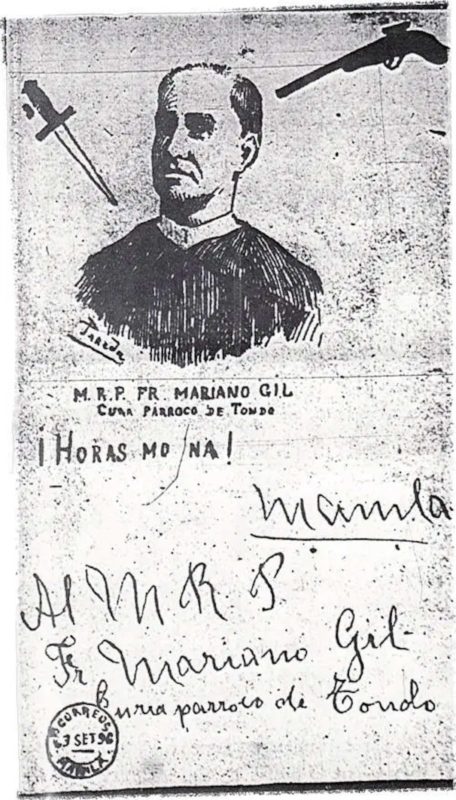To kill a priest

A death threat sent to Fr. Mariano Gil who exposed the Katipunan.
Andres Bonifacio (1863-1897), the Supremo of the Katipunan and the Father of the Philippine Revolution, was also known, though unofficially, as the President of the Tagalog Republic or Katagalugan.
In Bonifacio’s mind, the Spanish friars were the abusive leaders who, like threatening dragons covered with spikes and loaded with bile, made the Filipino people suffer. Bonifacio read Noli and Fili, in which Rizal on countless times depicted frailocracy as evil. Furthermore, Bonifacio seemed to have agreed with Marcelo H. Del Pilar, who literally branded colonialism as a government of the friars, when the Spanish bishops and the priests together constituted a powerful, permanent, well-organized, and solid political entity (La frailocracia Filipina. 1889).
According to Epifanio de los Santos (1871-1928), Bonifacio has repeatedly recalled Del Pilar’s inflammatory attack on the friars: “Oh, Friar, full of cruelty, whose only thought is to vanquish and to overcome; oh. Friar, without pity on the blood of innocent ones.” Bonifacio apparently read the mind of Marcelo H. Del Pilar, a 33-degree Mason and an intransigent rationalist, who concluded that the friars were “those who sprouted lush riches from their soil and subsoil,” los que hicieron brotar de su suelo y subsuelo exuberantes riquezas.
Andres Bonifacio had three other brothers – Ciriaco, Procopio, and Troadio – who, like him, were KKK fighters, fearless but brutally inclined. When some Spanish friars became prisoners of the Philippine Revolution of 1896, one of his brothers “had whipped them (friars) with thorns and with reeds on the soles of their feet,” as Telesforo Canseco, an eyewitness, testified.
Some KKK leaders called Bonifacio an atheist, knowing his brothers’ irreligious attitude and his own fearless attempts to destroy whom he perceived as the enemies of the people, not excluding men of the cloth,
Bonifacio wasn’t afraid to kill God’s representatives. Dr. Pio Valenzuela, a top KKK officer, gives a detailed account in his memoirs: “One day in July 1896, after my return from Dapitan, the Secret Chamber of the Katipunan held a meeting in which two resolutions were approved: One referred to the assassination of Fray Mariano Gil…” The first clerical target was the Augustinian cura parroco of the Santo Niño de Tondo Parish, the same friar who would expose the KKK and its rebellious plans in August 1896.
“During the moonlit nights of July, between 8 to 10 o’clock, we kept watch in the vicinity of the Tondo church waiting for the parish priest to come down from that building; it being his habit to take a walk along the streets near the convent on such nights. Emilio Jacinto, our third companion in the enterprise, fell ill and could not join us. For three nights, Bonifacio and I kept our watch, armed with a revolver and a dagger, but during those successive nights the priest did not come down,” according to Valenzuela.
A few days later, Dr. Valenzuela discussed the nerve-wracking matter with Apolinario Mabini, who advised that the plot should be carried out only at the last minute, when KKK was ready to revolt, to which Dr. Valenzuela agreed.
Could the fear of God, takot sa Diyos, have coexisted in the same warrior who had no qualms to torture and kill a man of the cloth, walang takot pumatay, in the name of freedom? At the height of the 1896 Revolution, on orders from Bonifacio, some of his men brought their friar-prisoners to Maragondon to torture and execute them. The townsfolk of Maragondon said, “No, you cannot execute them here and we refuse to have the blood of friars spilled in our town.” To those who read the signs of the times, did it matter that one year later Maragondon would be the site of the 1897 execution on Mount Nagpatong of Andres Bonifacio and his brother Procopio?
In our time, we have another Filipino president who also would have no qualms about eliminating his enemies, Catholic bishops and priests included.
Jose Mario Bautista Maximiano (facebook.com/josemario.maximiano) is the author of MDXXI: 500 YEARS ROMAN CATHOLIC (Claretian, 2020) and 24 PLUS CONTEMPORARY PEOPLE: God Writing Straight with Twists and Turns (Claretian, 2019).

